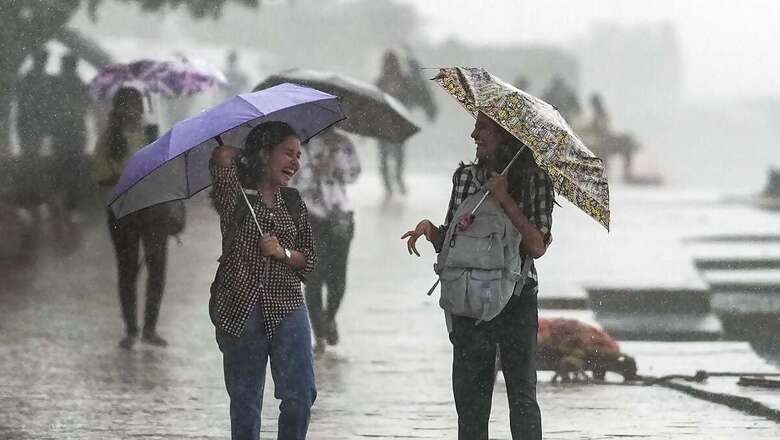
views
Monsoon rains in India started withdrawing from the northwest of the country on Monday, more than a week later than normal, India Meteorological Department (IMD) said in a statement. Monsoon in India generally begins in June and starts to retreat by September 17. But this year, the retreat started on September 25, helping to reduce a precipitation deficit after the driest August in more than a century hit some summer crops.
“The southwest monsoon has withdrawn from some parts of Rajasthan. Conditions are favourable for the withdrawal of the monsoon from more northern states in the next one week,” a senior IMD official said.
Notably, this year is the 13th consecutive delayed Monsoon retreat. The withdrawal of monsoon from northwest India marks the beginning of its retreat from the Indian subcontinent.
Significance of Monsoon In India
The monsoon, the lifeblood of India’s USD 3 trillion economy, delivers nearly 70 per cent of the rain needed to water its farms and recharge reservoirs and aquifers.
Any delay in the monsoon’s retreat means a longer rainy season, which can significantly impact agricultural production, particularly for northwest India where monsoon rainfall plays a crucial role in the Rabi crop production.
Arrival of Monsoon In India
Typically, the southwest monsoon makes its onset over Kerala by June 1 and covers the entire country by July 8. It starts retreating from northwest India around September 17, withdrawing entirely by October 15.
According to the IMD, the withdrawal of monsoon from extreme north-western parts of the country is announced based on three major synoptic features after September 1–no rainfall activity over the region for five days on the trot; the establishment of anticyclone in the lower troposphere (850 hPa and below); and a considerable reduction in moisture content as inferred from satellite water vapour imageries and tephigrams.
Rain Deficit This Year
India has received 796.4 mm of rain during this monsoon season so far, compared to a normal of 843.2 mm, representing a deficit of six per cent.
It was 9 per cent below average in June before rebounding to 13 per cent above average in July. The weather office then registered 36 per cent below-average rains last month. Monsoon rains so far in September are 17 per cent above average, according to IMD.
Rainfall between 94 per cent and 106 per cent of the long-period average (LPA) is considered normal.
Normally, the country receives an average of 870 mm of precipitation during the four-month monsoon season (June to September).
Reason Behind Lesser Rains
In a pre-monsoon briefing, the IMD had predicted a normal monsoon for India, albeit on the lower side of normal. It had, however, cautioned that El Nino — warming of waters in the Pacific Ocean near South America — might influence the latter half of the southwest monsoon.
El Nino results in weaker monsoon winds and drier conditions in India.
However, normal cumulative rainfall over the country during the monsoon season doesn’t mean even spatial and temporal spread of precipitation. The Indian monsoon refers to inherent fluctuations and changes that occur over time due to various natural factors.
This is called natural variability. However, research shows climate change is making monsoon more variable. Increased variability means more extreme weather and dry spells.
This year, India experienced a rainfall deficit in June but saw excessive precipitation in July due to consecutive western disturbances over northwest India and a favourable phase of the Madden-Julian Oscillation (MJO), known for increasing convection in the Bay of Bengal and the Arabian Sea.
MJO is a large-scale atmospheric disturbance originating in tropical Africa and travelling eastward, typically lasting 30 to 60 days.
August 2023 marked the driest month since 1901 and the hottest ever recorded in India, attributed to the strengthening of El Nino conditions.
However, September brought excess of rain due to multiple low-pressure systems and the positive phase of MJO.
(With Inputs from PTI and Reuters)




















Comments
0 comment